Valmiki Tiger Reserve: At The Junction Of Himalayan Fauna
First published in Sanctuary Asia,
Vol. 44
No. 4,
April 2024
By Gopinathan Maheswaran
I first visited the Valmiki Tiger Reserve (VTR) in January 2020 for my project on the hispid hare, with little information available about the reserve and its species. The first few days, all I found was a paltry collection of old hispid hare Caprolagus hispidus pellets from two grassland patches, and I almost decided not to return. However, the more I explored the reserve to look for birds, my primary research focus, the more I began to develop an interest in this oft-ignored tiger reserve and its smattering of pristine forest patches that had never been fully surveyed. I therefore chose to find and update a bird species list for this lesser studied region of Bihar. After this initial 15-day stay in 2020, I visited the reserve four times, each visit lasting over two weeks. I was determined to focus exclusively on the study of its avian diversity.
Though Valmiki does not have a native rhino population, a few individuals from across the border in Nepal seek asylum in Indian terrain during the monsoon, when the gushing waters of the Gandak river carries them across. According to the Forest Department staff, the norm until a few years ago was for India to return these displaced rhinos once the flood situation improved. Now, owing to increasing costs and the manpower involved in transferring the flood-driven individuals back to Nepal, the Government of India and the Bihar Forest Department have ended the practice. While most rhinos thrive in their new home, a few have unfortunately met with tragic deaths after being crushed by speeding trains near the Madanpur range in the VTR.
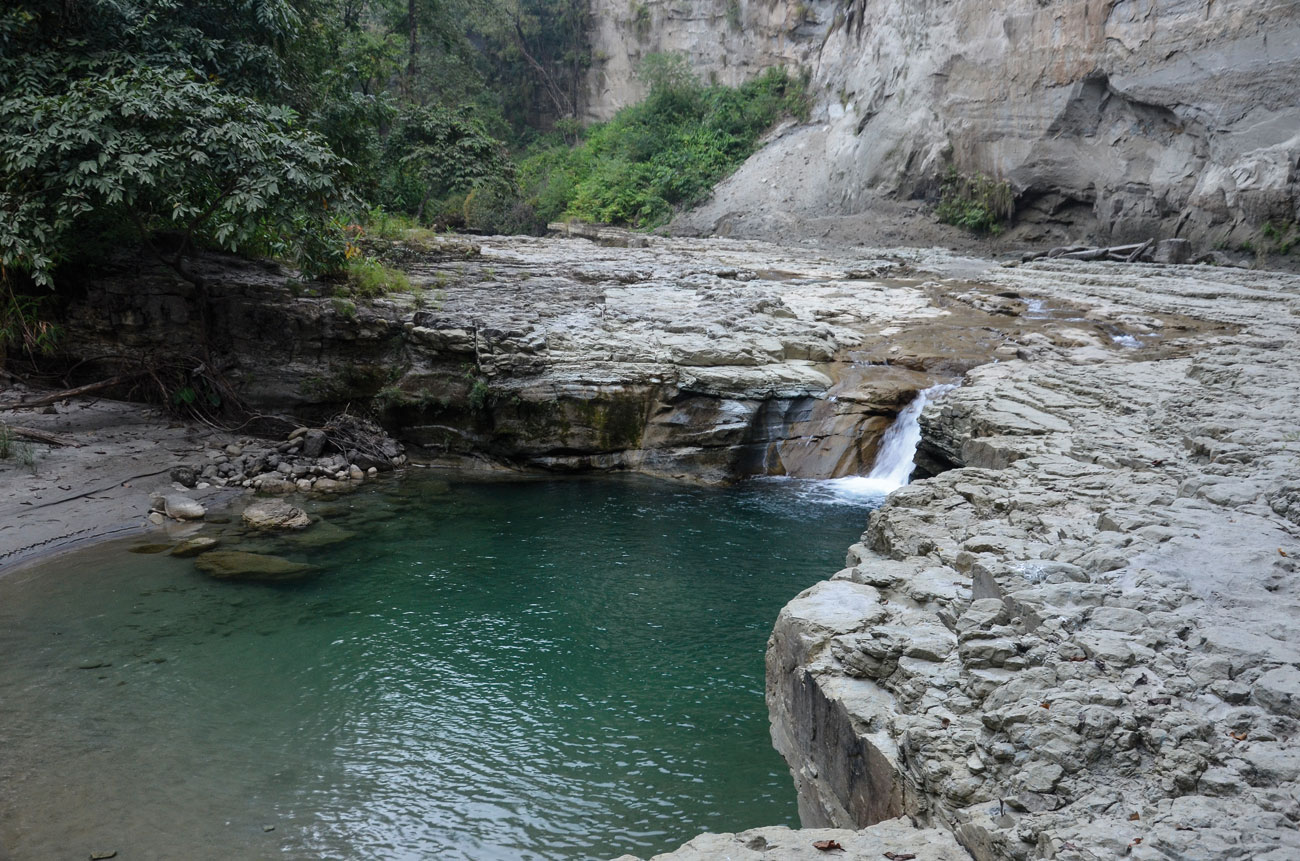
The Valmiki Tiger Reserve in Bihar is a paradise for birders. This tiger reserve and its smattering of pristine forest patches had never been fully explored by the author and after an initial visit in 2020, he chose to revisit the reserve four times to focus exclusively on the study of its avian diversity. Photo: Gopinathan Maheswaran.
Wild Hare Chase
It was after studying the hispid hare in the Dudhwa Tiger Reserve (Uttar Pradesh) and the Jaldapara National Park (West Bengal) that I decided to visit Valmiki located between these terai landscape PAs. Unlike Dudhwa and Jaldapara, Valmiki lacks large grasslands, yet a few patches in divisions one and two seemed promising when I first visited the reserve in 2020. In compartment S-28 of VTR’s division one, I found old pellets which I suspected belonged to the hispid hare, along with thatch cuttings on a river bed. Grass cutting and fuelwood collection by villagers was high. And when I subsequently visited this patch in 2021, 2022 and 2024, the condition had worsened and a Mikania micrantha (aka the mile-a-minute vine) infestation had compounded the problem. Although tall grasslands in the Madanpur area of the VTR seemed promising for the hispid hare, monsoon floods that inundated part of the habitat to a height of up to two to three metres for over a couple of months ruled out the possibility of the species surviving here. I thoroughly combed this grassland in my first visit but found no evidence of the hare.
It was difficult to deploy camera traps as the risk of theft or damage was high, a problem the Forest Department also faced, but one that had reduced considerably down the years. I suspect there is a tacit understanding between villagers and the Forest Department that the former be allowed to collect grass and fuelwood, and in exchange the cameras, meant only to monitor animal movement are left alone.
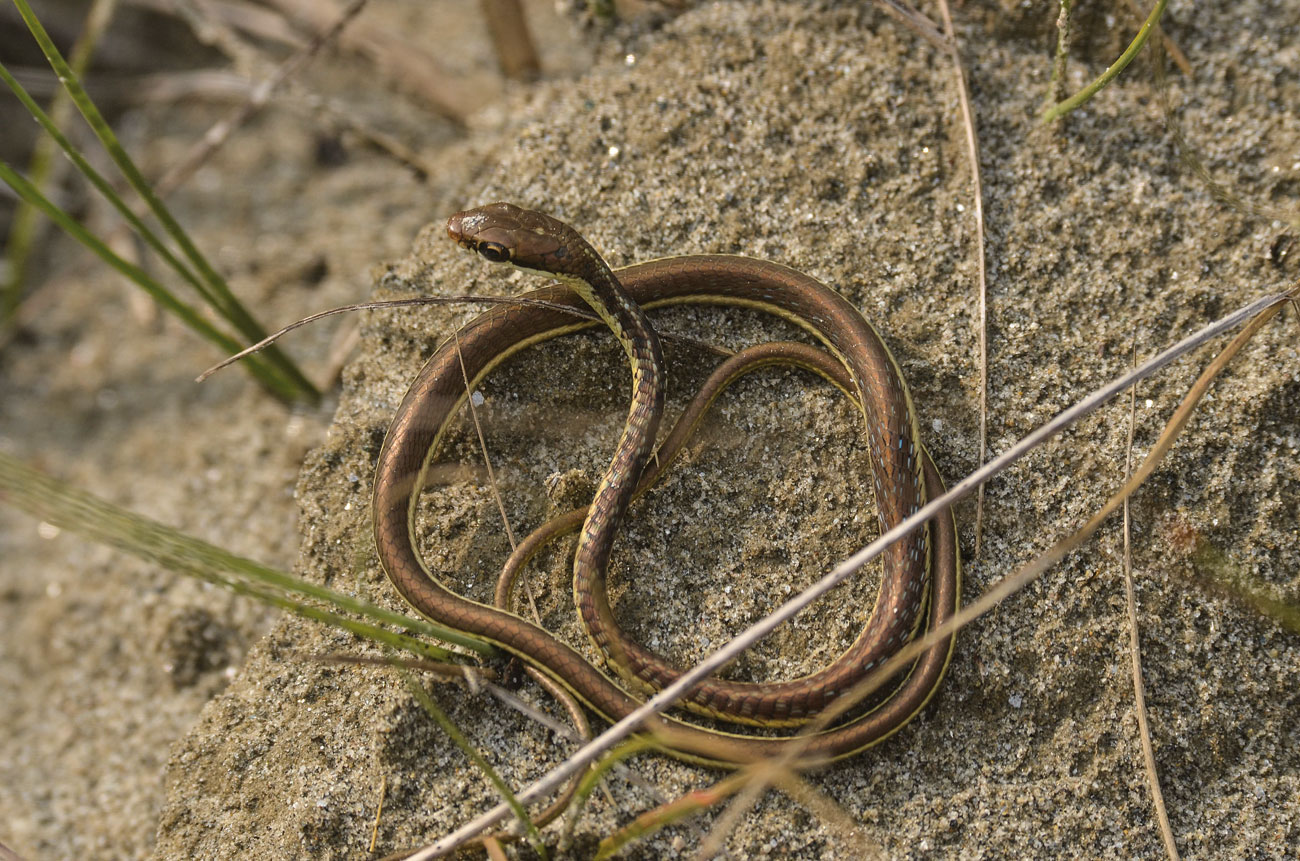
Owing to its geographical location almost at the halfway mark of the Himalayan range, the Valmiki Tiger Reserve hosts bird, mammal and herpetofauna species common to both the Eastern Himalaya and Western Himalaya, along with species from neighbouring Nepal. Photo: Gopinathan Maheswaran.
Interestingly, the tigers of Valmiki, as in Pilibhit and Dudhwa, favour fringe sugarcane fields, where herbivores go out in search of rice and wheat during the monsoon. Conflict between villagers and wildlife, especially tigers and sloth bears, is increasing at the Valmiki Tiger Reserve, and we can only hope this does not get worse. Sources confirm that Valmiki’s tigers travel as far as eight to 10 km. outside the reserve in search of prey, leading to conflict and consequent clashes between villagers and the Forest Department.
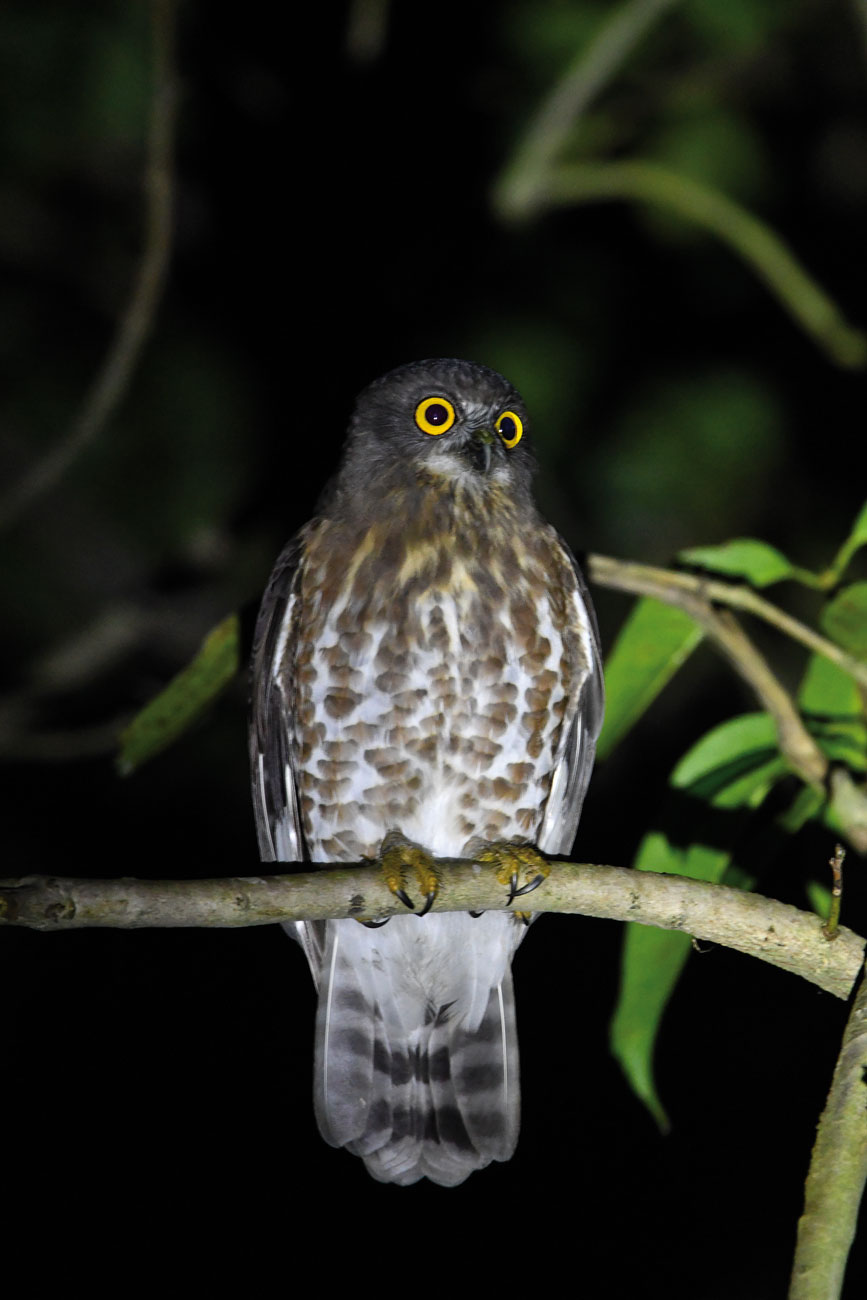
The Brown Hawk Owl Ninox scutulata, also called the Brown Boobook, is a resident of South Asia. It lacks ear tufts like other owls, giving it a ‘hawk-like’ appearance. When the author began venturing deeper into the reserve, he had very interesting bird sightings. Photo: Gopinathan Maheswaran.
On A Wing And A Prayer
After that first visit, although I believed that the reserve (apart from compartment S28) would not support hispid hare, I began venturing deeper into the other habitats where I had very interesting bird sightings. The presence of Himalayan elements – both Eastern and Western – surprised me and I took up a three-year study on birds in VTR, as barely any information was available about the reserve’s avian assemblages. By January 2024, along with my team of dedicated birders, I recorded 221 species, and believe the count could rise to around 300 species. Sightings of Kalij Pheasants and Red-billed Blue Magpies on the fringes of the forest, close to the sugarcane fields in Gobardana and Manguraha, highlight the fact that the forests of Valmiki could likely also host other Himalayan species. The Streaked Spiderhunter was recorded from wild banana plantations in the reserve, suggesting an extended range beyond the Eastern Himalaya. When I visited Parewadah, north of Gobardana, water from the hills fed the streams in a canyon formed by high mountains. Watermarks on the mountain walls on account of monsoon flashfloods suggested heights of 10 to 15 m. on mountain walls that rose to 120 m. The exposed walls are covered with mosses, which attracts avians such as the Wallcreeper – a Himalayan species. Forest patches along Parewadah have broad-leaved evergreen trees, supporting species such as the Red-headed Trogon, which was reported for the first time from the reserve in 2021, probably the western-most record of this Eastern Himalayan species.
Further up, enroute to the Someshwar Temple near the Nepal border, the habitat changes to broad-leaved evergreen forest with grass-covered slopes. Here I recorded Lesser Necklaced and White-crested Laughingthrushes, Collared Owlets, and multiple flocks of Common Woodshrike. Amitava Majumder, a colleague, was delighted to spot the White-capped Bunting – a migratory species that has never been reported from VTR. The grass-covered slopes between the Triveni SSB camp and Someshwar Temple support several interesting species including Grey-crowned Prinia – a vulnerable species with a very narrow distribution range in the Himalaya and the Black-chinned Babbler – a super ‘skulker’, or bird that hides in dense foliage. Anindya Naskar, a Kolkata boy who accompanied me on my 2024 survey, was able to photograph the elusive Black-chinned Babbler, a shy grassland species that moves swiftly within thick grass clumps. The grasslands of Madanpur also support Siberian Rubythroats and West Himalayan Bush Warblers – both Western Himalayan migratory species recorded for the first time in Valmiki. Such sightings further consolidate the importance of the reserve in supporting transitory migrants through the region.
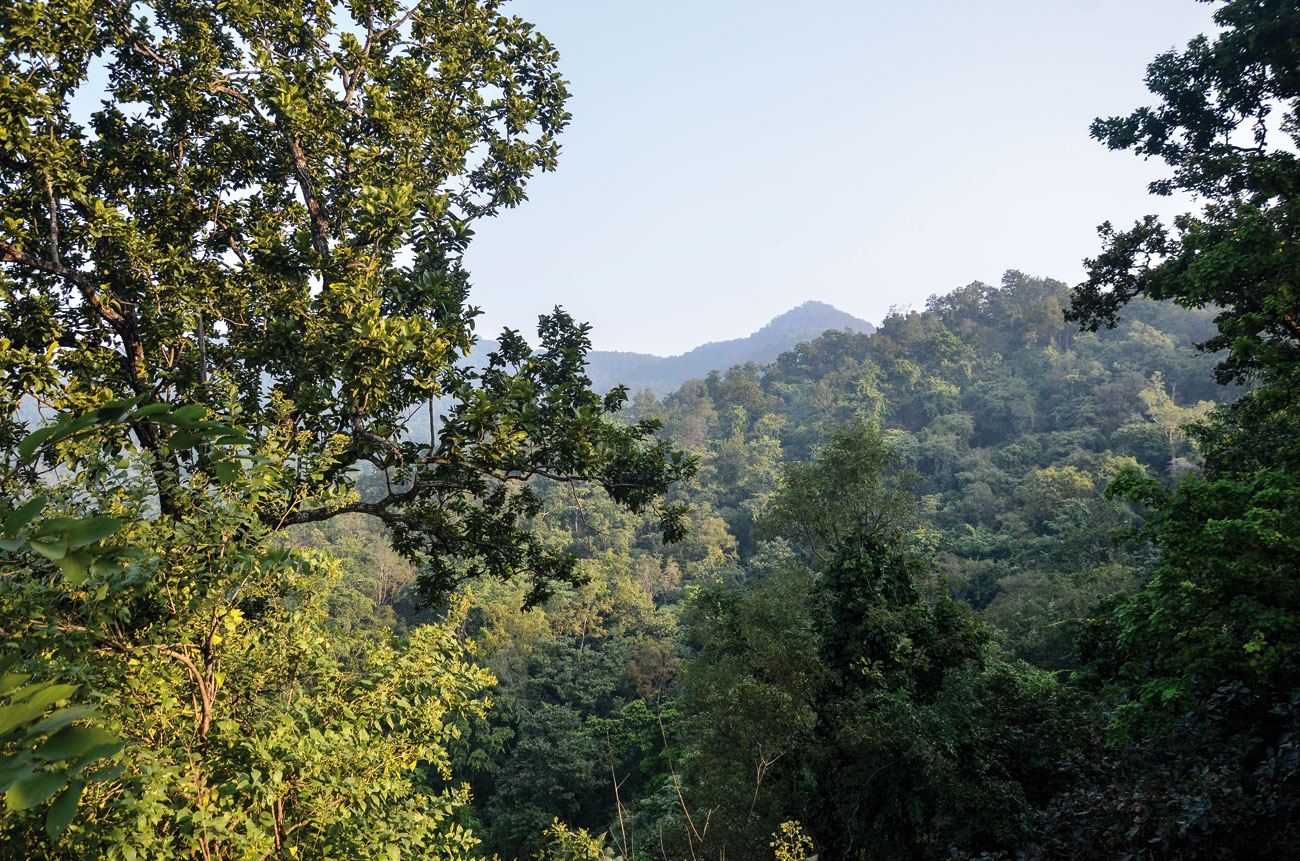
The vegetation of VTR mostly comprises moist deciduous forests, broad-leaved evergreen forests, and grassland patches. Though Valmiki does not have a native rhino population, a few individuals from across the border in Nepal seek asylum in Indian terrain during the monsoon, when the gushing waters of the Gandak river carries them across. Photo: Gopinathan Maheswaran.
The area also supports species belonging to the terai landscape. Though common to northern India and the Gangetic Plains, the Red Junglefowl is so common here in Valmiki that I was able to count 40 individuals (male and female) in a single flock, foraging in bamboo clumps close to a dirt road near the Lalbethia Anti-poaching Camp. The flock’s proximity to a road frequently accessed by villagers and forest staff, highlights the protection the species gets and reaffirms the fact that there is little or no local poaching of avians. I have never seen a flock comprising 40 Red Junglefowl in any other Protected Area in India. It was delightful to observe them in the golden evening sunlight as they fought among themselves over morsels of food. A little away from the junglefowl, I spotted a flock of peafowl foraging nonchalantly in the middle of that same dirt road.
Valmiki is an equally important habitat for mammals. Sightings of the crab-eating mongoose Herpestes urva indicated that the species’ range extended further west than presumed. The previous known distribution was only up to the Dooars of northern West Bengal. A few years ago, a WWF-India team camera trapped an individual in VTR, and since then the species has been sighted regularly in rivers and streams, especially in Parewadah. Troops of the near threatened Terai langur Semnopithecus hector foraging high up in the acacia trees and even higher treetops of sal are a common sight all over VTR.
A Hidden Gem
Named for the legendary Rishi Valmiki, the Valmiki Tiger Reserve (VTR) at the India-Nepal border on the banks of the Gandak river in Bihar is a paradise for birders. Owing to its geographical location almost at the halfway mark of the Himalayan range, it hosts species common to both the Eastern Himalaya and Western Himalaya, along with species from neighbouring Nepal, as the reserve is contiguous with the Chitwan National Park to the north and the Parsa Wildlife Reserve of Nepal to the north-east. Yet people outside Bihar seldom know about this reserve, keeping the tourist footfall to a bare minimum. Once impacted by Naxal activity, the reserve now has a healthy wildlife density, thanks to the efforts taken by the Bihar Forest Department, the presence of SSB paramilitary camps, and anti-poaching camps set up for tiger conservation. With a total forest area of about 901 sq. km., it is part of the Valmiki-Chitwan-Parsa Terai Arc Tiger Conservation Landscape, which spreads across a total area of about 3,549 sq. km. VTR forms a tiger corridor with Chitwan (932 sq. km.) and Parsa (499 sq. km.), and has been designated by the World Wildlife Fund as one of the Level 1 Tiger Conservation Units (TCU), where long-term survival of tigers is being ensured, of the Indian subcontinent. The movement of tigers between Valmiki and the two neighbouring Protected Areas of Nepal allows for the much-needed gene exchange required to maintain healthy and viable tiger populations.
The Other Side
Apart from human-animal conflict, the reserve has other problems arising from anthropogenic pressures. The Pandoi river near Manguraha is a hotbed of electro-fishing by people from nearby villages. During the day, one can see hundreds using a conventional car battery and connected iron rod to wastefully neutralise fish as small as a few millimetres, and seldom as big as a foot in length, depriving all fish-eating birds of their food. Another problem involves the extraction of gold fragments from the river by diverting streams and sifting through sediments for fine particles that may generate an income of Rs. 300 to 500 a day for men and women living in nearby villages.
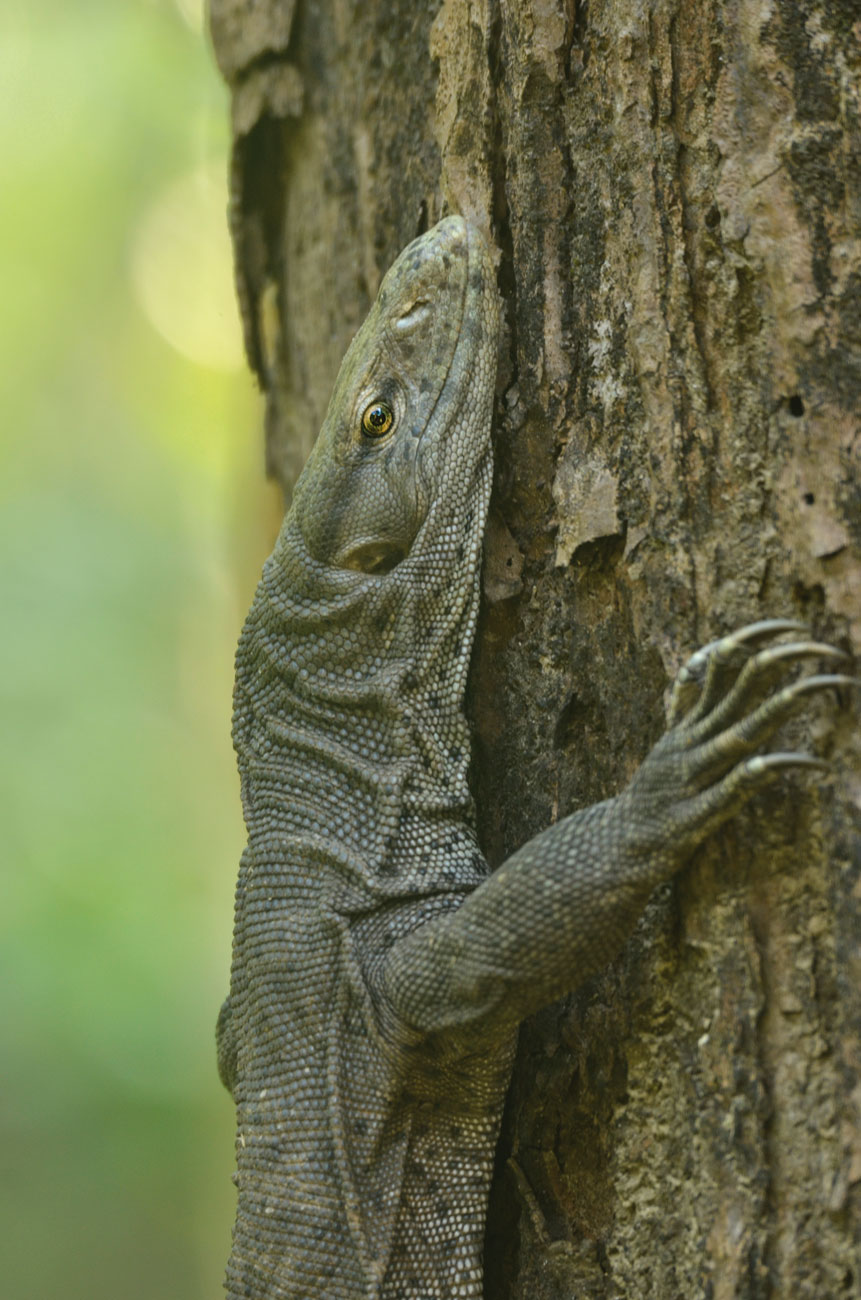
A Bengal monitor Varanus bengalensis climbs up a tree with its dagger-like long claws. The diverse denizens of VTR’s forests, rivers and grasslands face threats on account of anthropogenic pressure including electro-fishing. Photo: Gopinathan Maheswaran.
My search for the hispid hare remained unfulfilled, but my eyes were opened to the abundant bird diversity of the Valmiki Tiger Reserve. The Protected Area’s avian and mammalian assemblages are a blend of Eastern and Western Himalayan species, combined with some belonging to the Gangetic Plains. This threatened landscape is a unique junction of hotspots that deserve more exploration and attention from birders, scientists, naturalists and tiger wallahs ready to give Bihar’s only tiger reserve its rightful due.
Gopinathan Maheswaran A scientist with ZSI, Dr. Gopinathan is documenting the breeding ecology of the Critically Endangered White-bellied Heron in Arunachal Pradesh. His work on the species’ foraging ecology has been published in peer-reviewed journals.






